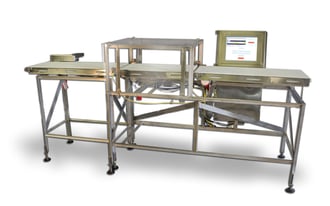Everything You Need to Know about In-Motion Checkweighers
In-motion checkweighing can be used for a wide variety of applications—enabling processes such as verifying package contents, checking product tolerances, identifying parts, classifying products, and checking for overload safety. Typically, the checkweighing system is an inspection station utilized after the manufacturing or packaging process. Checkweighers are most commonly used in the food and beverage, pharmaceutical, cosmetics, and various industrial industries. Businesses use checkweighing to reap the benefits of:
- Enhanced weighing accuracy
- Increased line speed
- Quality control
- Compliance assurance with certain government regulations
How it Works
- The Basics
 Fully automated in-motion checkweighing systems measure the weight of an object as it’s in motion. Most systems use a type of conveyor belt to move a stream of products through the weighing area. At the end of the process, the checkweight controller directs the downstream diverter gates to route and organize product based on its recorded weight.
Fully automated in-motion checkweighing systems measure the weight of an object as it’s in motion. Most systems use a type of conveyor belt to move a stream of products through the weighing area. At the end of the process, the checkweight controller directs the downstream diverter gates to route and organize product based on its recorded weight.
- Real-World System Example
In-motion checkweighing systems have received significant technological upgrades in recent years, and the AD-4961 checkweigher series from A&D Inspection exemplifies the best of the modern features now available. Armed with a newly developed digital load cell and an ultra-high-speed processing module, high-level precision of 0.08g (3σ)*₁ can be realized with this machine. With this high-accuracy checkweigher, your business can minimize the giveaway of materials above the specified weight and contribute to reductions in production costs.
One of the system’s main draws is its incredible internal operating system, which will save you time and increase your organizational efficiency. The system allows product images to be quickly uploaded into the machine’s computer through a USB flash drive—allowing for simple and quick uploads and product identification. Products can then be divided into 10 different groups with up to 100 products able to be recorded within each group.
The construction of the AD-4961 consists of four units: an infeed conveyor unit, a weighing conveyor unit, a control unit, and a base unit, allowing fast and simple assembly. In the case of system shutdown, service engineers are not required to resolve the issue. Just simply replace the unresponsive module yourself, so that you can shorten system downtime and maximize production efficiency. By inputting throughput (products per minute) or belt speed (m/min), optimal weighing conditions can be automatically set—making it easy to weigh products precisely without inputting various settings. To wrap it all up, your weighing results are instantaneous and automatically recorded in a USB flash drive during the process.
Checkweighing Applications
- Verifying Package Contents
In-motion checkweighers are great for weighing packages to ensure they have been filled to the proper level or that they contain the appropriate amount of parts. A huge variety of products—ranging from boxed food, glass bottles, cosmetic containers, etc.—can be verified through the use of checkweighing systems. Boiling down the specifics even further, in-motion checkweighing can determine if there is the correct number of items in a box, boxes in a carton, and cartons in a pallet.
- Checking Product Tolerances
Verifying a manufactured product’s weight through a checkweigher affirms it will comply with specified design tolerances. For example, a medical device coating company can detect improperly produced products by using an in-motion checkweighing system to verify each part’s weight as it falls out of the mold—identifying imperfections in the coating process through issues in the thickness of the coating that can be revealed by the presence of excess weight.
- Classifying or Grading Products
Checkweighing systems can sort a mix of different items according to their weight and divert them to their proper packaging station for classifying or grading purposes.
- Identifying Parts
A checkweigher can automatically identify that the correct parts have been delivered to your business by affirming a specific parts identity through its verified weight.
- Overload Safety Check
Many regulatory items have to be weighed often to ensure they aren’t violating safety limits—in-motion checkweighing systems are a great solution to make sure these products are in compliance with any governed regulations.
How Alliance Scale Can Help
Looking to purchase an in-motion checkweigher for your company? Check out the current listings we have on our website here or get in touch with one of our experts to help you find the best system for your needs.
Not only can we provide you with the perfect weighing system to run your business, but we can also inspect them for use. Alliance Scale provides expert repair and inspection services across a broad range of commercial and retail applications in the greater New England area.


